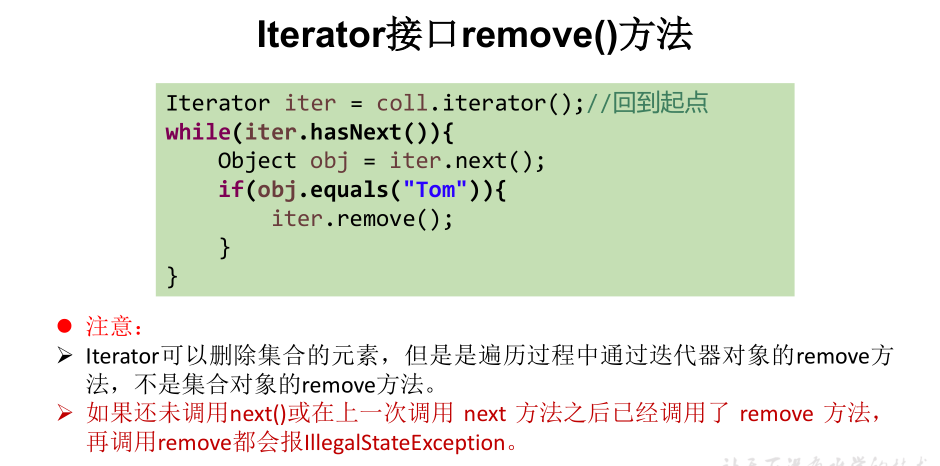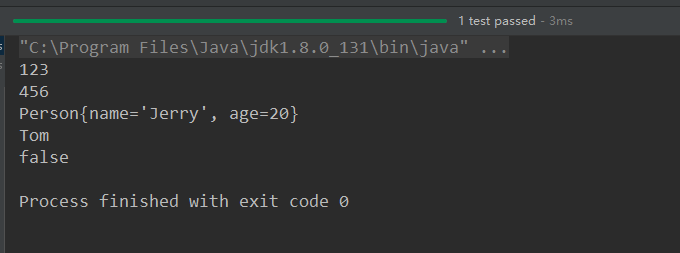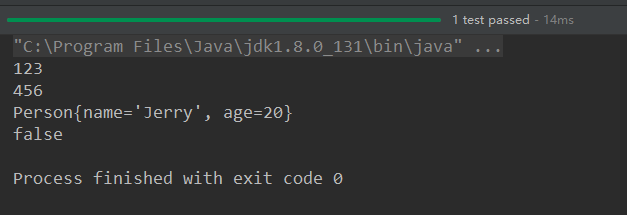使用 Iterator 接口遍历集合元素:
Iterator对象称为迭代器(设计模式的一种),主要用于遍历 Collection 集合中的元素。
GOF给迭代器模式的定义为:提供一种方法访问一个容器(container)对象中各个元
素,而又不需暴露该对象的内部细节。 迭代器模式,就是为容器而生。类似于“公
交车上的售票员”、“火车上的乘务员”、“空姐”。
Collection接口继承了java.lang.Iterable接口,该接口有一个iterator()方法,那么所
有实现了Collection接口的集合类都有一个iterator()方法,用以返回一个实现了
Iterator接口的对象。
Iterator 仅用于遍历集合,Iterator 本身并不提供承装对象的能力。如果需要创建
Iterator 对象,则必须有一个被迭代的集合。
集合对象每次调用iterator()方法都得到一个全新的迭代器对象,默认游标都在集合
的第一个元素之前。



* 集合元素的遍历操作,使用迭代器Iterator接口
* 1.内部的方法:hasNext() 和 next()
* 2.集合对象每次调用iterator()方法都得到一个全新的迭代器对象,
* 默认游标都在集合的第一个元素之前。
* 3.内部定义了remove(),可以在遍历的时候,删除集合中的元素。此方法不同于集合直接调用remove()
@Test public void test1(){ Collection coll = new ArrayList(); coll.add(123); coll.add(456); coll.add(new Person("Jerry",20)); coll.add(new String("Tom")); coll.add(false); Iterator iterator = coll.iterator(); //方式一: // System.out.println(iterator.next()); // System.out.println(iterator.next()); // System.out.println(iterator.next()); // System.out.println(iterator.next()); // System.out.println(iterator.next()); // //报异常:NoSuchElementException // System.out.println(iterator.next()); //方式二:不推荐 // for(int i = 0;i < coll.size();i++){ // System.out.println(iterator.next()); // } //方式三:推荐 ////hasNext():判断是否还有下一个元素 while(iterator.hasNext()){ //next():①指针下移 ②将下移以后集合位置上的元素返回 System.out.println(iterator.next()); } }

@Test public void test2(){ Collection coll = new ArrayList(); coll.add(123); coll.add(456); coll.add(new Person("Jerry",20)); coll.add(new String("Tom")); coll.add(false); //错误方式一: // Iterator iterator = coll.iterator(); // while((iterator.next()) != null){ // System.out.println(iterator.next()); // } //错误方式二: //集合对象每次调用iterator()方法都得到一个全新的迭代器对象,默认游标都在集合的第一个元素之前。 while (coll.iterator().hasNext()){ System.out.println(coll.iterator().next()); } } //测试Iterator中的remove() //如果还未调用next()或在上一次调用 next 方法之后已经调用了 remove 方法, // 再调用remove都会报IllegalStateException。
@Test public void test3(){ Collection coll = new ArrayList(); coll.add(123); coll.add(456); coll.add(new Person("Jerry",20)); coll.add(new String("Tom")); coll.add(false); //删除集合中"Tom" Iterator iterator = coll.iterator(); while (iterator.hasNext()){ // iterator.remove(); Object obj = iterator.next(); if("Tom".equals(obj)){ iterator.remove(); // iterator.remove(); } } //遍历集合 iterator = coll.iterator(); while (iterator.hasNext()){ System.out.println(iterator.next()); } }
